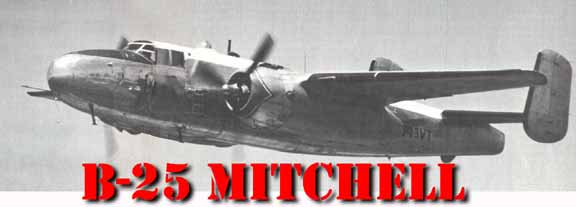If I live to be 30 (
Ed: I was a real
smart ass at that age!), I'll never forget the feeling sitting at
the end of the runway, right hand wrapped around two throttles, looking
out at 3,600 horses in two big radial engines. The 22,000 pounds of airplane
around me agitated gently but noisily in their wake. Now I know how George
Plimpton felt facing Green Bay, but at least he could lie down and play
dead-I wouldn't be playing. I was about to fly the big, beautiful B-25
bomber!
At that moment I just wasn't geared toward bombers. Fighters, maybe, or
aerobatics, or homebuilts. But big, hulking, roaring bombers-definitely
not.
Prepared or not, I suddenly found myself in the left seat of N543VT, a
North American B-25N, Mitchell. junior Burchinal, proprietor of Flying
Tigers Air Museum, was in the right seat, shouting at me to do this and
that. Yes, I'm multi-engine rated, but most of my limited experience has
been in a couple of moth-eaten Apaches, and the B-25 bears as much resemblance
to an Apache as I do to Raquel Welch. Ninety percent of my flying is done
with only stick, throttle, and rudders to worry about-no boost pumps,
feathering systems, emergency gear extension, bleed hole icing, Vmc, constant-speed
props. Now I had to think about shimmy dampers, exhaust stacks, oil coolers,
hydraulic accumulators, and brake pressures.
| |
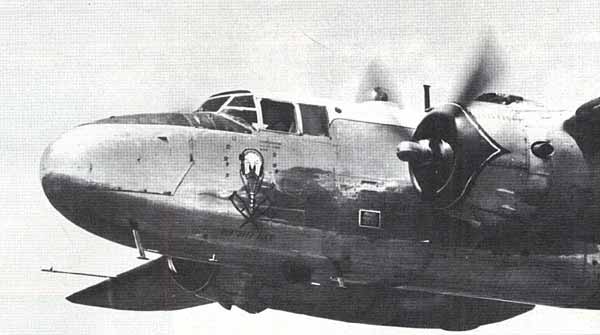 |
| |
Burchinal's B-25, if seen on the line
today, would be viewed as a really tired looking old airplane
because it had never been restored, as is the case with every
B-25 today. In 1971, when this was written, there were dozens
of them around in "still flying but roachy" condition
and no one wanted them. None had been restored yet. |
Flying a 10-ton aluminum ingot isn't something you just wander out
to your local FBO and do. In any case, I was going through the World
War II flight course at the Flying Tiger Air Museum in Paris, Texas.
My original intent was to fly the fighters, but the B-25 is also part
of the program, intended to broaden your education—and it does,
in spades! Heavy in this case means about 17,000 pounds empty, with
an allowable emergency overload of nearly 45,000 pounds. That's more
than my hometown weighs!
This particular Mitchell probably would be more correctly termed a VB-25N,
since it originally was an executive transport for the RCAF. Most B-25s
don't have dual controls, but this one, along with many of the TB-25s
still flying, is completely set up for two pilots, as a training ship.
Originally, I was to go up with junior and drive the 25 around for an
hour or so, just to see how it felt. I began to like the idea of flying
the big moose, however, and I soon heard myself saying things about
"more time" and the words "type rating" kept popping
up. Type rating! That's the special license it takes to carry passengers
in airplanes that weigh more than 12,500 pounds, and the B-25 weighs
that much with one wing and both engines removed. It takes a different
type rating for each type of airplane. The change in program meant I
would have to learn the airplane inside and out, and that's a lot of
territory. Burchinal is a FAA-designated examiner for the B-25, and
I knew he would be tough.
My first "introductory" flight made me feel like crawling
into the bomb bay and going for a walk outside. I thought the Mustang
was a departure from the Citabria; the B-25 is in another world entirely.
When we got up into the air and over the practice area, Junior signaled
for me to take it. I took the wheel, and a slight out-of-trim condition
caused the nose to drop. I automatically pulled the nose up—or
at least I tried. I was flying with my left hand, my right resting lightly
on the throttles. I could hardly pull the wheel back with one hand!
I released the throttles and brought the other hand over to help, barely
getting the nose up level. I finally had enough sense to wheel in some
up trim. The controls couldn't be that heavy! I made a turn to the left,
or at least my hand did, but the control wheel resisted my attempts
to move it. Grasping it firmly, determined to do it with one hand, I
forced one end down, and the wings responded smartly enough by rolling
obediently into a left bank-then the nose started to fall. With the
30-degree bank I was holding, I had to force the wheel to the rear to
keep the nose from falling. It had started losing altitude the second
I started to roll. I wasn't prepared for the heavy control pressures.
Just to prove to me that the airplane would fly, junior reached up and
punched a red button on the console between us that started moving levers.
As I was watching him, I saw the right propeller come to a stop, its
blades edged into the wind. He diddled with some trim wheels and sat
there, hands off, boring along with only one engine going. Satisfied
that I had been suitably impressed, he fired up the other engine and
headed back to his field.
I expected a long approach, nose high, with lots of power, dragging
it in over the wires and stomping on the brakes to get stopped. He aimed
the nose at the runway and I figured we were going to make a high speed
pass. When we were over the middle of the runway at about 200 knots
indicated, he pulled up hard to the left in a tight chandelle. While
he was doing this, he started scurrying around the cockpit, throwing
this and yanking that. Suddenly, I realized he was doing a 360-degree
overhead approach, fighter style, right off the deck in a B-25. At the
top of the chandelle, we were downwind opposite the end of the runway.
He brought the throttles back, turned into the field and beautifully
completed the 360-degree turn as he plunked us down on the runway. The
man certainly knows his airplane.
I knew I had my work cut out for me, so I started memorizing systems
and going through the preflight checklists. When all the gizmos and
gadgets are explained, you find there aren't that many things that are
drastically different from what you're used to. It's still an airplane,
and you must check the oil and gas, the struts and tires, the controls
and so forth.
The B-25 does have several particulars that we little-airplane drivers
don't see often and that must be checked. For one, the shimmy damper
has a little nubbin, a small rod for all practical purposes, that sticks
out of the top. If it doesn't stick out at least three-eighths of an
inch, you don't fly. On airplanes as big as the 25, if the shimmy damper
fails, it can destroy the airplane. Junior told me about a Mitchell
he saw that lost the damper on landing roll-out: it sheared rivets and
buckled sheets back into the wings, completely wrecking it. He lost
one on the B-26 while taxiing into a parking place, and in the time
it took to roll 10 feet all the Plexiglas was shaken out of the nose.
Just below the shimmy damper is a knurled cap screwed on to a bolt-like
affair that goes through the strut. Under the cap is a pin that can
be pulled out, allowing the nose strut to turn freely for towing. The
cap has to be finger tight. You really have to depend on the half-inch-thick
book that makes up the preflight checklist.
| |
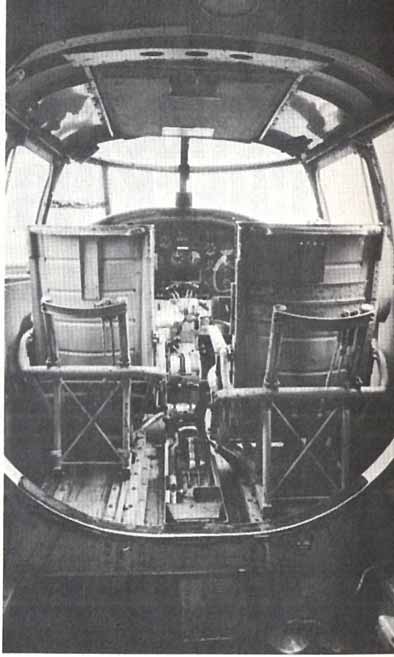 |
| |
The view from just behind the top turret
position ahead of the bomb bay bulkhead. At the bottom, under
the curved frame, is a short ladder that goes to the hatch on
the bottom of the airplane. |
You enter the flight deck through a hinged hatch that contains a ladder,
located in the belly of the airplane, about in line with the propellers.
When you climb up, you find yourself standing in a small room, about
six feet square, going from the top to the bottom of the fuselage. It
has a couple of jump seats and a Plexiglas bubble in the top for navigation
work. The forward side of this area is only about three feet high, opening
into the back of the cockpit.
Getting up into the pilot's seat is a major operation. The cabin roof
is fairly low and the seats are close together, which means you have
to walk on the row of knobs and levers that cover the space on the floor
between the seats.
The instrument panel isn't nearly as complex as would be expected. It's
actually simpler than in many light twins. Some of the instrument placement
is rather odd, and every available inch of side panel is covered with
emergency system controls.
The throttles, props, and mixtures are where you'd expect them to be,
and most of the rest of the switches for starting, fuel management,
and feathering are on the trapezoidal-shaped panel just in front of
the throttles. The props are feathered by depressing the appropriate
large red button on this panel. The Ham-Standards feather in less than
10 seconds and unfeather in about twice that time. Since feathering
is by electrically driven pumps, it's a good idea to check the generator
panel on the right side of the cockpit to make sure both generators
are working, or if one is out, that you don't feather the engine with
the good generator.
I must have spent at least eight hours sitting in the airplane running
through emergency procedures and making imaginary touch and goes. Since
I'm not used to handling any kind of procedure at all, it took some
effort even to remember to bring the gear up, or push the props up on
final. I spent so much time in there and would get myself so wound up
psychologically flying patterns in my mind, that I’d get the adrenaline
pumping and one leg would be twitching uncontrollably. Yeah, I was just
a little hyped!
On my second hop we did stalls and all the other exercises that go into
learning an airplane's bad habits.
Satisfied that we had enough altitude and there was no traffic around,
I started reducing power and bringing the nose up, feeling for the stall.
I thought an airplane this big would flop on the ground, tail first,
when you stalled it nose high, but I was pleasantly surprised. We were
light, so the stall didn't show up until we were way down around 70
knots. When it broke, there was no mistaking it, but it wasn't as violent
as in many modern twins. It jumped once, dropping the nose through the
horizon, and rolled left slightly. Keeping the nose down and adding
power, we had flying speed in less than a thousand feet, losing no more
than 1,200 feet, and I had been slow adding power. The only hard part
was the physical exertion involved. As the airplane slowed down and
the sink rate went past the peg, the controls lost some of their effectiveness,
calling for bigger control deflections, which meant more arm muscle.
| |
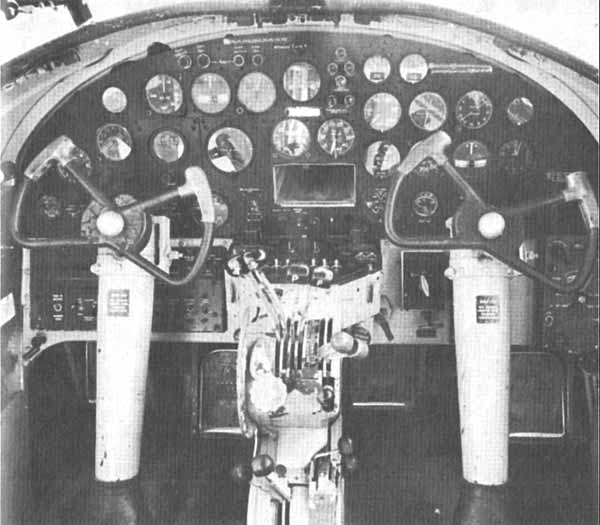 |
| |
The panel itself is pretty straight forward
but the console has a herd of levers, switches and buttons that
have to be deciphered. The big control yoke is right against your
chest during flair and the runway disappears behind the nose.
|
Single-engine drills in the B-25 are really fun (spoken sarcastically).
One thing is certain: when an engine shuts down, there is no doubt which
is the "idle foot." My good foot was working so hard that
after each hop it took several hours for my knees to stop shaking. During
my multi-engine training, I remember seeing an engine feathered just
once; that's all the FAA requires. Burchinal feathered one everywhere
except at the gas pump. There are only two things to remember when feathering
a B-25; remember what the Vmc is for your weight, and move your fanny
forward in the seat because you have to be seven feet tall for your
legs to push the rudder all the way down. I found myself wedging my
shoulder against the seat and practically standing on the rudder, lying
sideways in the seat, right hand frantically cranking in rudder trim
located at the base of the control console. Once the trim is in, the
airplane is a pussycat, but if you don't start cranking trim right off
the bat, the pussycat will eat one leg, and maybe your entire lunch.
The handbook says the minimum single-engine control speed at 27,000
pounds is an incredible 126 knots (145 mph). We investigated Vmc and
found that at our reduced weight of around 22,000 pounds we could fly
it right down to 80 knots indicated and still hold the nose straight.
Doing single-engine stalls, I got very good at leaping on that power
and bringing it back quickly. You forget to reduce power only once in
a power-on, stalled, engine-out situation, then the B-25 does all the
talking and you do the listening.
For my first landing, we flew a wide downwind at 120 knots and I ran
through the landing check as fast as I could because the airport was
disappearing rapidly. Burchinal played co-pilot. I called for the gear
and at the same time pushed the props up to 2200 rpm, where they would
stay until we were on the ground. Mixture went to auto-rich and boost
pumps went first to low, then high. By this time I was way past the
airport, so I brought the power back a little and started a turn on
to base. The second I started the turn, I knew what junior had been
talking about when he mentioned heavy aircraft and the way they need
power and don't need steep banks. When the wing went down, the airplane
started sinking immediately and I had to advance power to catch it.
Not even in the Mustang did I have this feeling of being behind the
airplane, of being rushed.
On base, I found myself using a lot of power just to maintain status
quo, cranking in trim every few seconds. I stuck up two fingers, indicating
to Burchinal I wanted half flaps, adding more power and trim. As I turned
final, I stuck up four fingers for full flaps and started gently reducing
power and struggling with the nose to get 110 over the fence. Then I
had 110 knots and Burchinal was yelling to bring the B-25 power back.
I thought he was crazy, that we'd never make the runway, but I killed
the power anyway, keeping my nose pointed at the numbers, 110 knots
on the gauge.
| |
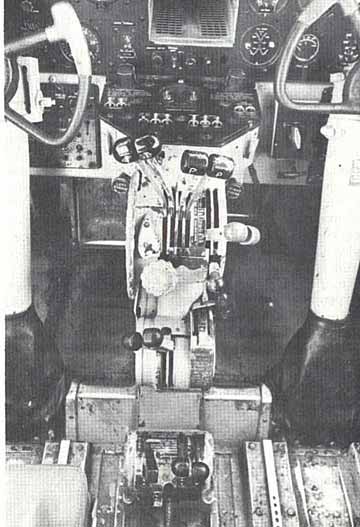 |
| |
The flat top of the console has all the
engine control stuff on it including the fuel boost and starter
switches. The big knobs on the two forward corners are the red
"feather" buttons for the props. At the bottom of the
console on the floor is the landing gear lever. |
I started bringing the nose up and Burchinal started yelling "Pull,
pull!" He grabbed the wheel and helped me. It turned out I was
flaring in the right place, but I would have touched down on all three,
or just a little nose high, but I would have been too hot. Burchinal
kept me pulling and we touched down with the nose in an impossibly steep
nose-high attitude, completely hiding the runway.
Roll-out was arrow straight and Junior cautioned me to be very, very
gentle on the brakes, because they are sensitive. My toes crept up on
the top of the rudder pedals and pushed as gently as they could. Jerk!
And the nose strut compressed as I nearly locked the brakes. They have
double discs and just need a whisper of pressure to stop the wheel.
Trying to taxi smoothly was a near impossibility.
Once we were on the taxiway, junior started telling me to call for what
I wanted, meaning flaps up, cowl flaps open, and boost pumps off. I
proved once and for all how calm and cool I was: In my gruffest, most
professional voice, I called out, "Gear up!" It just wasn't
my day.
Takeoffs are really, really exciting-possibly even more so than in the
Mustang, because you know the tricycle gear will take care of the takeoff
roll and you have more time to bask in the glory of flying a bomber.
In the Mustang, I was always a little too busy for sight-seeing. After
making sure that everything on the quadrant was full forward and the
boost pumps were on, I'd call for one-quarter flaps and start the throttles
forward. As soon as the airplane is moving, the rudders are effective
and you only have to touch the brakes just once before the rudders come
in. The power must come up slowly to keep the prop governors from surging
and you have to monitor manifold pressure to keep it under 44 inches.
Considering the amount of airplane around you, the acceleration is fantastic
and the noise is even more so. There are different kinds of noise. In
the Mustang, it was almost unbearable. In the B-25, it was just as loud,
but it didn't seem to bother me. It was like the difference between
a rifle and a shotgun. The Merlin in the Mustang cracked and barked,
but the R-2600s in the Mitchell roared like a tired lion, and had a
softer, less harsh noise.
Since I knew Vmc was 80 knots, I picked the nose up at 80 knots and
let the airplane run on the mains until it indicated 100 knots, lifting
it off and calling for, or grabbing, the gear as soon as possible. On
my second takeoff, as soon as we broke ground and I had yanked the gear
up, Junior nonchalantly caged the right engine. Aside from a few frantic
moments and a foot that was turning purple, the B-25 climbed out as
if it didn't even know half its engines were out.
On the type-rating check ride, Junior tossed a single-engine landing
and a single-engine go-round into the same hour. Junior has a knack
of working you right up to the edge of your talent, forcing you to learn
as you go.
The single-engine landing was really interesting because we were five
miles from the field when he punched it out. This meant I was going
to have to drive it in, play with all those levers, fight the airplane,
and land it as well. At first, I tried to figure out how much power
it was going to take to keep us up with the gear down and half flaps,
and then I remembered that I didn't dare put the gear down until I had
the runway made. The airplane won't fly with only one engine and the
gear hanging out.
Finally, I was on final, keeping it high just in case, waiting until
the last second to drop the gear, remembering it would take longer to
extend with just one hydraulic pump working. As soon as the gear started
out and I reduced power to let the airplane down, it became just another
of those pull, pull, pull kind of landings. It took nearly four hours
in the B-25 before I got used to pulling so hard and getting the nose
so high.
(Editor’s Note: You’re going to just love the next paragraph!
Things have definitely changed since 1971) Pound for pound, B-25s are
the cheapest flying machines in the business. You can buy ex-military
jobs all day for $5,000 and superplush executive conversions never run
over $10,000, usually averaging around $7,500, complete with lavatories,
bunks, and your own private bar. They're just the thing to put you in
competition with Hugh Hefner's DC-9. They are fast, easy to fly, fairly
forgiving, just oozing with romance, and give you instantaneous he-man
status. They cruise at an effortless 200 to 220 mph and can top most
weather. Then why don't more people want them? It's because of the Wright
R2600s. At today's prices, it costs over $500 to fill the Mitchell's
1,000-gallon tanks (Ed: now that’s funny!) and that gives
you less than five hours of flying fun. About the leanest you can run
it is 120 to 140 gallons per hour; closer to 160 gph, if you're going
somewhere. It's not exactly the airplane for Sunday afternoon puddlejumping,
but it grows on you, like a big, friendly dog. Too bad we can't afford
to have one as a house pet.
B-25's and "Catch
22"
When they made the movie of Joseph Heller's slightly off-center
anti-war movie, they unwittingly saved the lives of the majority
of B-25's still flying today. Frank Tallman and company was task
with coming up with something like 25 flying B-25's and, in so
doing, resurrected a bunch of derelicts that had only a few years
left before becoming beer cans. The movie is worth seeing if nothing
else to watch mass takeoffs of Mitchells from the dusty strip
they hacked out of the Mexican desert.
|
Mitchell Shopping
Although Mitchells have recently become the darlings of the restore-it-totally-accurately
crowd and millions (literally) have been spent tracking down and
installing every little bit of military hardware, the airplanes
are still reasonably (by warbird standards) priced. It's seldom
you see one over $500,000 and lots are down around $300,000. However,
there are some that haven't had the center section rebuilt, and
that's where corrosion loves to hide, so it's usually smarter
to pay more for a better airplane.
|
